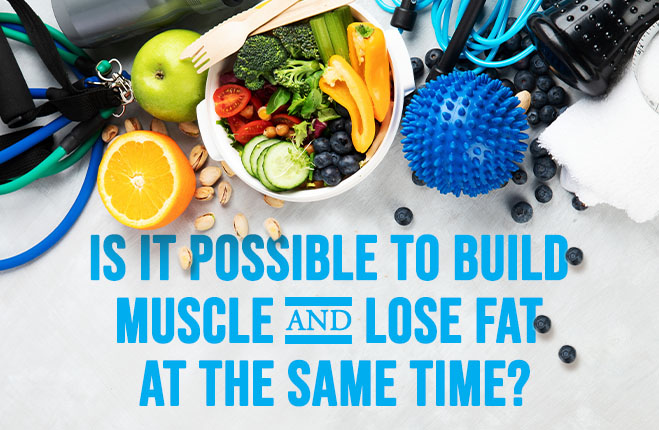Building muscle and losing fat at the same time was once considered impossible, however, more recent observations have revealed that increasing muscle mass while reducing body fat is in fact achievable (Barakat et al., 2020).
Reducing fat mass requires an energy deficit to force the body to essentially cannibalize itself (a catabolic state): we want the body to use its own long term energy stores – our adipose, or fat, deposits. A catabolic state does not usually provide sufficient energy for the body to simultaneously build more tissue (an anabolic state), i.e., more lean muscle mass, and reduce body mass (ideally lose fat mass). When a person is in an extremely high catabolic state – or a large energy deficit – we often see reductions in both fat mass and lean mass (Weiss et al., 2017) with some studies demonstrating lean tissue losses as high as 25 percent of total weight loss (Willoughby et al., 2018) while in a fat loss phase.
To build more lean mass we usually need to add more ‘building material’ to provide additional resources in the form of both protein and total calories (yes, including carbohydrate!) to increase the amount of lean tissue (Kim & Song, 2019; Wachsmuth et al., 2022). Think of building an extension on a house – you need more bricks. The body needs more protein and more energy in order to build more lean tissue than it already has. Providing the body more energy in the form of extra calories is not the ideal condition to force it to consume stored energy that it already has, i.e., burn its long-term fat stores.
What can be done?
Eating adequate protein and including exercise, especially resistance training will promote preservation of lean muscle mass during a fat loss diet (Cava et al., 2017).
Recent research has demonstrated an increase in lean muscle mass in an experimental group who also showed greater fat mass reductions than the control group while consuming protein at 2.4g/kg of fat free mass while in an overall calorie deficit in conjunction with a resistance training program and anaerobic exercise (Longland et al., 2016).
There are some conditions that are generally accepted which affect whether you can lose fat and gain muscle at the same time:
- Being a novice at resistance training.
- Having had a long break from resistance training.
- Consuming adequate protein and overall calories.
How do I know if I am losing muscle while losing fat?
Scale weight may not give an accurate indication of fat loss, as an increase in muscle mass while simultaneously dropping body fat may show as an increase in total body weight!
One way to get a feel if you are heading in the right direction is to check that your strength is increasing by monitoring the progression of your lifts in the gym. If the scale weight is stable or increasing but your waistline remains stable or decreases then you are likely losing fat, and either preserving muscle mass or perhaps gaining some lean tissue.
However, the best way is to check your progress with a DEXA scan.
Ideally you should obtain your measurements prior to commencing your program and then get a progress scan (depending on the duration of your fat loss phase) and a then final scan when you have completed your fat loss phase to see if your plan has been successful.
fat loss; fat-free mass; muscle hypertrophy; aesthetics; bodybuilding; body composition; physique
BRENDAN BARRY (AEP, AES, ESSAM)
Accredited Exercise Physiologist
References
Barakat, C., Pearson, J., Escalante, G., Campbell, B., & De Souza, E. (2020). Body Recomposition: Can Trained Individuals Build Muscle and Lose Fat at the Same Time? Strength & Conditioning Journal, Publish Ahead of Print. https://doi.org/10.1519/SSC.0000000000000584
Cava, E., Yeat, N. C., & Mittendorfer, B. (2017). Preserving Healthy Muscle during Weight Loss. Adv Nutr, 8(3), 511-519. https://doi.org/10.3945/an.116.014506
Kim, H. N., & Song, S. W. (2019). Association between carbohydrate intake and body composition: The Korean National Health and Nutrition Examination Survey. Nutrition, 61, 187-193. https://doi.org/10.1016/j.nut.2018.11.011
Longland, T. M., Oikawa, S. Y., Mitchell, C. J., Devries, M. C., & Phillips, S. M. (2016). Higher compared with lower dietary protein during an energy deficit combined with intense exercise promotes greater lean mass gain and fat mass loss: a randomized trial. Am J Clin Nutr, 103(3), 738-746. https://doi.org/10.3945/ajcn.115.119339
Wachsmuth, N. B., Aberer, F., Haupt, S., Schierbauer, J. R., Zimmer, R. T., Eckstein, M. L., . . . Moser, O. (2022). The Impact of a High-Carbohydrate/Low Fat vs. Low-Carbohydrate Diet on Performance and Body Composition in Physically Active Adults: A Cross-Over Controlled Trial. Nutrients, 14(3). https://doi.org/10.3390/nu14030423
Weiss, E. P., Jordan, R. C., Frese, E. M., Albert, S. G., & Villareal, D. T. (2017). Effects of Weight Loss on Lean Mass, Strength, Bone, and Aerobic Capacity. Medicine and science in sports and exercise, 49(1), 206-217. https://doi.org/10.1249/MSS.0000000000001074
Willoughby, D., Hewlings, S., & Kalman, D. (2018). Body Composition Changes in Weight Loss: Strategies and Supplementation for Maintaining Lean Body Mass, a Brief Review. Nutrients, 10(12), 1876. https://doi.org/10.3390/nu10121876
